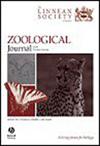Long-bone microanatomy in elephants: microstructural insights into gigantic beasts
IF 2.8
2区 生物学
Q1 ZOOLOGY
引用次数: 0
Abstract
One of the greatest challenges of terrestrial locomotion is resisting gravity. The morphological adaptive features of the limb long-bones of extant elephants, the heaviest living terrestrial animals, have previously been highlighted; however, their bone microanatomy remains largely unexplored. Here we investigate the microanatomy of the six limb long-bones in Elephas maximus and Loxodonta africana, using comparisons of virtual slices as well as robustness analyses, to understand how they were adapted to heavy weight-bearing. We find that the long bones of elephant limbs display a relatively thick cortex and a medullary area almost entirely filled with trabecular bone. This trabecular bone is highly anisotropic with trabecular orientations reflecting the mechanical load distribution along the limb. The respective functional roles of the bones are reflected in their microanatomy through variations of cortical thickness distribution and main orientation of the trabeculae. We find microanatomical adaptations to heavy weight support that are common to other heavy mammals. Despite these shared characteristics, the long bones of elephants are closer to those of sauropods due to their shared columnar posture, which allows a relaxation of morphofunctional constraints, and thus relatively less robust bones with a thinner cortex than would be expected in such massive animals.大象长骨的显微解剖:巨兽的显微结构
地面运动的最大挑战之一是抵抗重力。大象是现存最重的陆生动物,其肢体长骨的形态适应特征此前已得到强调;然而,它们的骨骼显微解剖在很大程度上仍未被探索。在这里,我们研究了大象和非洲Loxodonta的六个肢体长骨的显微解剖学,使用虚拟切片的比较和鲁棒性分析,以了解它们是如何适应负重的。我们发现大象四肢的长骨显示出相对较厚的皮质和髓质区域几乎完全充满了小梁骨。这种骨小梁具有高度的各向异性,其方向反映了沿肢体的机械载荷分布。骨骼各自的功能作用通过皮质厚度分布的变化和骨小梁的主要方向反映在其显微解剖中。我们发现了其他重型哺乳动物对重物支撑的微观解剖学适应。尽管有这些共同的特征,大象的长骨更接近蜥脚类动物的长骨,因为它们都有柱状的姿势,这使得它们的形态功能限制得到了放松,因此相对来说,大象的骨骼不那么强壮,皮质也更薄,这在如此庞大的动物中是预料不到的。
本文章由计算机程序翻译,如有差异,请以英文原文为准。
求助全文
约1分钟内获得全文
求助全文
来源期刊
CiteScore
6.50
自引率
10.70%
发文量
116
审稿时长
6-12 weeks
期刊介绍:
The Zoological Journal of the Linnean Society publishes papers on systematic and evolutionary zoology and comparative, functional and other studies where relevant to these areas. Studies of extinct as well as living animals are included. Reviews are also published; these may be invited by the Editorial Board, but uninvited reviews may also be considered. The Zoological Journal also has a wide circulation amongst zoologists and although narrowly specialized papers are not excluded, potential authors should bear that readership in mind.

 求助内容:
求助内容: 应助结果提醒方式:
应助结果提醒方式:


